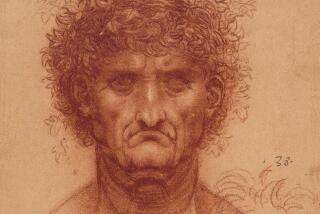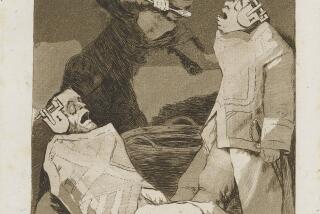ART REVIEW : Mannerism’s Paean to Creative Complexity
- Share via
Today’s ultrachic crowd patronizes restaurants whose chefs concoct exquisite taste sensations from unusual marriages of ingredients. In the 1500s, sophisticates at the European courts were swooning over works of art that displayed extraordinary complexity, fantasy and ingenuity--virtuosic performances expressly designed for an epicurean society.
The “stylish style” of the hour was Mannerism, the decadent aftermath of the High Renaissance that first appeared in Italy in 1520. “Mannerist Prints: International Style in the Sixteenth Century,” at the County Museum of Art (to Oct. 9), traces the development of this movement with 148 engravings, etchings and woodcuts by leading and lesser lights of the age from Italy, France and the Netherlands, selected from Mary Stansbury Ruiz’s important bequest of more than 600 prints.
Mannerism was, above all, a celebration of the creative powers of the artist and the taste of the connoisseur. Patrons who would formerly have ordered up depictions of specific religious or mythological scenes were now so giddily entranced by sheer artistic skill that they left the subject unspecified.
Artists reveled in the creation of figures with impossibly serpentine postures, amusingly ghastly expressions and eye-popping musculature (an exaggeration of Michelangelo’s rendering of the body beautiful).
Enormous care was lavished on the invention of the bella figura, an isolated uncomfortable-looking human specimen whose posture owed more to the artist’s cleverness in setting difficult goals for himself than to any notion of natural behavior.
Master engraver Hendrik Goltzius, working from a design by Cornelis Cornelisz. van Haarlem, allowed Icarus to tumble to his death in a pose at once ridiculously refined and deliciously vulgar.
Some works contain large casts of bit players who nearly obscure the stars. In Jacques de Gheyn II’s engraving “The Conversion of St. Paul,” based on a drawing by Karel van Mander, it takes a bit of searching among the rumps of soldiers and horses to find the drowsy-looking seated gentleman who is Saul of Tarsus, blinded by a ray of heavenly light.
But the finest Mannerist prints rise above the curious ornamentation and bizarre rhetorical devices of the age to reflect extraordinary intensity and dramatic focus.
Waving grasses, circling birds, the undulating skeletons of mysterious beasts and striding nudes with streaming hair create a hypnotic rhythm in a famous engraving of a witches’ procession attributed to Marcantonio Raimondi after a design by Giulio Romano.
Parmigianino, one of the foremost Mannerist painters, infuses an etching of “The Entombment” with a caressing play of light and shadow. The long, boneless curve of Christ’s arm underlines the deep mournfulness of the scene.
In Jacques Bellange’s etching and engraving “Martyrdom of St. Lucy,” the maiden who refused to worship idols is a luminous vision, sinking to her knees with a knife in her throat while the ornately appareled pagan crowd stare and gossip.
Bellange, active in the early 17th Century, marks the very end of the Mannerist era, when its languid excesses were challenged by the hot-blooded vigor of a new artistic generation.
More to Read
The biggest entertainment stories
Get our big stories about Hollywood, film, television, music, arts, culture and more right in your inbox as soon as they publish.
You may occasionally receive promotional content from the Los Angeles Times.










